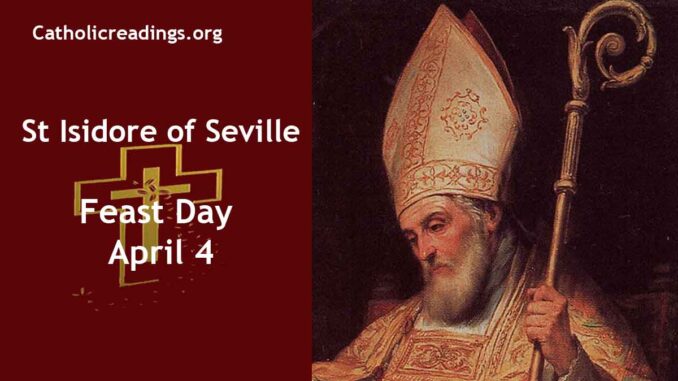St Isidore of Seville was the archbishop of Seville. He was born in 560 AD in Cartagena, Spain and died on April 4 636 AD (aged 75–76) in Seville, Spain.
We celebrate his feast day on April 4 every year in the Catholic Church.
St Isidore was the Bishop of Seville and is the Patron Saint of
- The Internet
- Computer users
- Computer technicians
- Programmers
- Students
| St Isidore of Seville Biography | |
|---|---|
 |
|
| Date of Birth | 560 AD |
| Place of Birth | Cartagena, Spain |
| Profession | Bishop, Confessor, and Doctor of the Church |
| Place of Work | Spain |
| Date of Death | April 4 636 |
| Place of Death | Seville, Spain |
| Feast Day | April 4 |
| Canonization | By Pope Clement VIII in 1598, Rome |
| Patron Saint of |
|
Saint Isidore of Seville Life History
Isidore’s birthplace was Cartagena, Spain, which was once a Carthaginian colony.
He was born to Severianus and Theodora, both of whom came from prestigious Hispano-Roman families of considerable social standing.
They were part of a powerful family that played a key role in the political and religious strategy that persuaded the Visigothic monarchs to abandon Arianism and embrace Catholicism.
Isidore had siblings who were also involved in the religious hierarchy.
His older brother, Leander of Seville, held the position of Archbishop of Seville before Isidore and during his tenure, he was known for his opposition to King Liuvigild.
Fulgentius, Isidore’s younger brother, served as the Bishop of Astigi at the beginning of the reign of the Catholic King Reccared. Isidore’s sister, Florentina of Cartagena, was a nun.
Leander was probably regarded as a sacred person in certain aspects, however, his method of teaching his younger brother Isidore raised concerns among many people, even at that time.
Although Isidore was capable and hardworking, Leander, who was much older, chose to use a teaching approach that depended on force and punishment.
It is challenging to understand why Leander thought that mistreatment rather than tolerance would be an efficient way of instructing Isidore, especially considering Isidore’s subsequent accomplishments.
On a certain day, the young boy reached a breaking point. He was feeling frustrated because he couldn’t learn as quickly as his brother expected him to, and also because his brother was treating him badly.
Due to this, Isidore decided to run away. However, even though he was able to escape from his brother’s harsh words and actions, he couldn’t escape from the feelings of failure and rejection that haunted him.
As he sat down, he noticed drops of water falling on a rock nearby. Even though the drops appeared to have no force and didn’t seem to affect the rock, Isidore saw that they had gradually worn holes in the solid stone over time.
Isidore realized that if he persevered in his studies, even small efforts would eventually lead to significant learning.
Perhaps he also harboured the hope that his efforts would eventually soften his brother’s heart.
However, upon returning home, Isidore’s brother was so frustrated with him that he confined him to a cell, likely in a monastery, to continue his studies.
His brother did not believe that Isidore would not run away again.
Isidore’s passion for learning inspired him to advocate for the creation of a seminary in every diocese in Spain.
What made his proposal unique was that he insisted that all areas of knowledge, including the arts and medicine, should be taught in these seminaries.
His book, the Etymologies, became a widely-used textbook for over nine centuries, providing readers with a comprehensive compilation of knowledge.
In addition to this work, Isidore also authored books on grammar, astronomy, geography, history, biography, and theology.
Spain was well ahead of the game when it came to studying Aristotle, thanks to Isidore’s open-mindedness.
Even before the Arabs reintroduced Aristotle to European students, Isidore had already reintroduced the philosopher to students in Spain.
When Isidore’s brother Leander of Seville died on either March 13, 600 or 601, Isidore took over as the Archbishop of Seville.
As soon as he assumed this position, he made it his priority to safeguard the interests of monks and took on the role of their protector.
Isidore aimed to unite the people and subcultures of the Visigothic kingdom into one nation, understanding that the well-being of his constituents relied on the amalgamation of remaining Roman and ruling barbarian cultures.
To achieve this, he employed all available religious resources and was successful in eradicating the Arianism heresy and thwarting the new Acephali heresy from taking root.
Isidore also reinforced religious discipline throughout his jurisdiction as Archbishop.
Isidore led the Second Council of Seville, which commenced on November 13, 619 during the reign of King Sisebut.
The council was attended by eight other bishops, all of whom were from the ecclesiastical province of Baetica in southern Spain.
After serving as the archbishop of Seville for over 32 years, St. Isidore died on April 4 636 AD.
Isidore’s contributions to the church and education did not go unnoticed. He was canonized by Pope Clement VIII in 1598, and in 1722, Pope Innocent XIII declared him a doctor of the church.
In more recent times, Isidore has been proposed as the patron saint of Internet users due to his dedication to using accumulated knowledge for the glory of God.
Isidore’s determination to make knowledge accessible to all and to use it in the service of God’s work is seen as an inspiration for those who seek to use the internet as a tool for learning and spreading the Gospel.
Related Links
Powered By SEO Experts
Follow @ReadingCatholic
